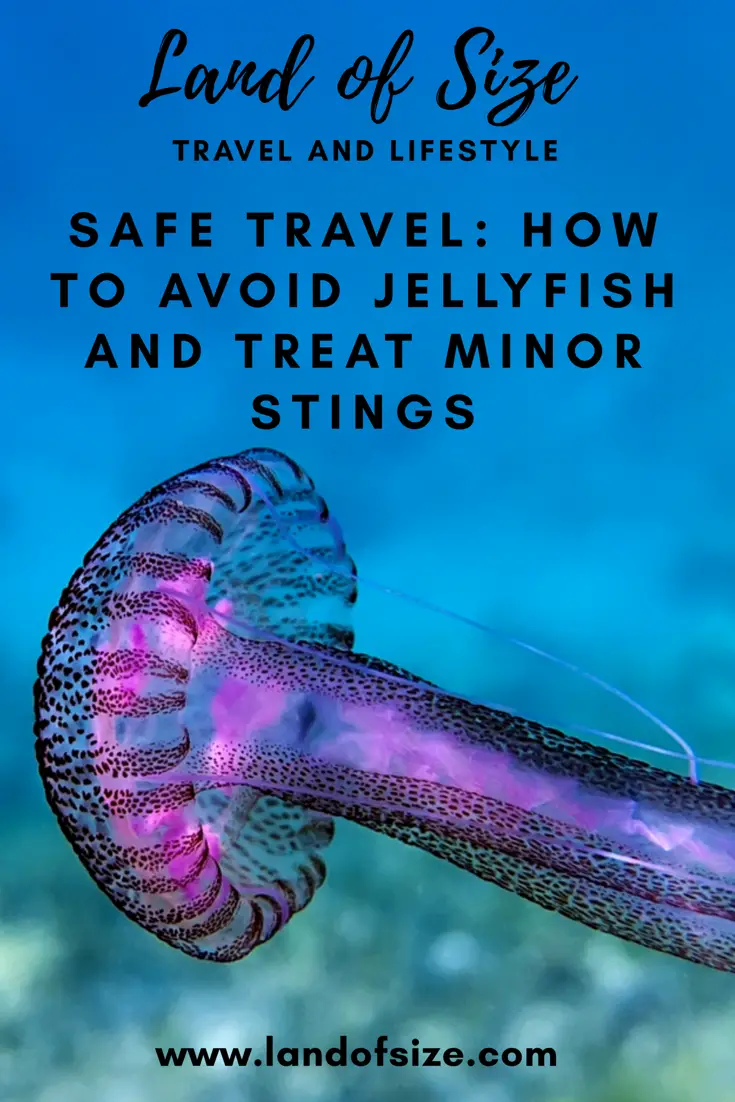Jellyfish can turn even the most peaceful swim or snorkel into an anxiety-inducing experience so here are some top tips to avoid jellyfish and how to treat minor stings.

This post may contain affiliate links
There are around 200 species of jellyfish in the world, and while many of them sting, only a few of them can kill you. The most deadly is the box jellyfish, but there are several others that you should avoid at all costs. In areas where deadly jellyfish occur, if you do see signs that say that they’re present, then avoid at all costs.
How to avoid jellyfish:
- Look for signs or purple flags that warn of jellyfish in the area.
- Speak to local guides, surfers, divers, lifeguards or fishermen to find out about how many jellyfish are about, and their whereabouts. They tend to be near the shore when the waters warm or it’s s windy day.
- Visit outside of jellyfish season.
- Steer clear of dead jellyfish that wash up on beaches as they can still sting. If you think that there will be jellyfish then consider keeping your sandals on instead of going barefoot.
- Consider wearing a wetsuit in jellyfish areas to help protect your skin from stings. You can get suits that are anti-sting but there is no foolproof body covering that will stop all stings. If you’re looking for turtles, they eat jellyfish which means that the stingers can remain in the water and they can still sting you – trust me!
- Be very careful when beach cleaning as jellyfish can have long tentacles and some can appear to look like litter such as plastic bags.
- Make big movements with your legs and arms to make currents to move the jellyfish away from you.
- Let people know if you see jellyfish, as people can become panicked when they see them in the water. Sometimes officials or lifeguards will even remove them if they wash up.
- There is anti jellyfish lotion that you can use to deter them, but I can’t recommend this as chemicals can affect marine life and I haven’t tried this myself.

Seek professional help if you have any concerns
If you have any concerns or acute pain with stings from jellyfish or being in the sea then seek medical attention immediately. I was stung by five jellyfish when snorkelling with manta rays in Nusa Lembongan. While they were sore afterwards, it was still a manageable amount of pain.
What do you do if you get stung by a jellyfish?
- Despite what you’ve heard or seen on an episode of Friends, urinating on a jellyfish sting doesn’t help and might even make it feel worse.
- It is better to clean the sting area with sea water (preferably warm) instead of fresh water.
- Vinegar can help stings, I’ve used it and it does really work, plus it’s not toxic to the marine environment.
- Tweezers can be used to remove stings if they’re embedded in the skin. You may need a magnifying glass and a friend as they can be hard to see! You can also scrape them out with a credit card.
- If you know that you have allergies to stings, be sure to bring your epipen but don’t use one if you don’t have an allergy.
- Once the stingers are out, you can treat the area with anti-histamine cream and take oral painkillers.
- Always consult a doctor or pharmacist if pain persists or if you have any concerns. My jellyfish stings hurt for the rest of the day after I got them in the morning, but they were fine the next day.
Read: What to pack in your personal medical kit for around the world travel
Get travel insurance
It’s always worth getting decent travel insurance if you’re going to be spending time in the sea. Insurance will cover you in the case of any injury or medical attention that you might need while you’re away. Click on the picture below to find a comprehensive insurance quote.
Don’t forget your water bottle:
Have you been stung by a jellyfish while on the beach or in the sea? Or do you have any tips for avoiding jellyfish? Share your stories in the comments below!
Pin this for later:





very clear and good article easy to understand. Thank you
We lived on a boat for five years in the Great Barrier Reef, Australia. We covered all our kids in full length Lycra suits, all year round when snorkelling. Irukangi jelly fish induce heart attacks and can occur in any season. Absolutely shocked snorkelling in Bali five days ago, when no warning given about the huge variety of jelly fish prevalent in Bali. Tourism authorities everywhere hide bad jelly fish bites. Lycra suits should be mandatory, especially in wet season.
Graeme Wilkinson